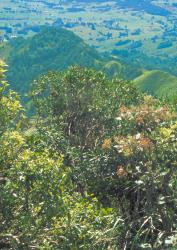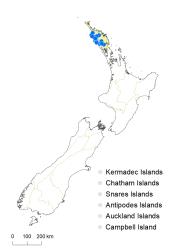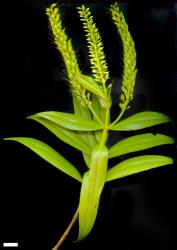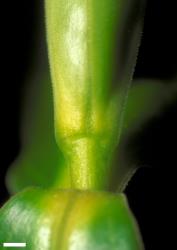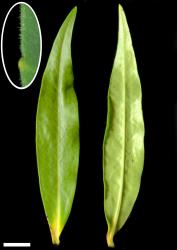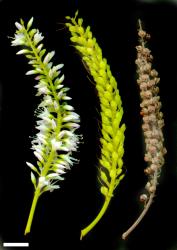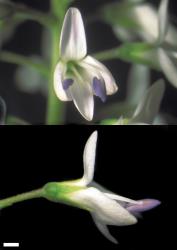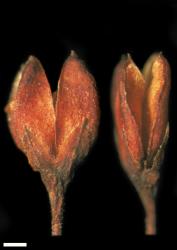- ≡ Hebe flavida Bayly, Kellow & de Lange, Illustr. Guide New Zealand Hebes 310 (2006)
Small tree, or sometimes bushy shrub, to 8 m tall. Stems erect, minutely eglandular-puberulent; hairs bifarious to uniform. Leaf bud distinct, its leaves appressed at margins until fully grown; sinus absent. Leaves opposite-decussate, erecto-patent to spreading; lamina thin to sub-coriaceous, linear-lanceolate to narrowly elliptic or oblanceolate, 30–135 mm long, 6–29 mm wide, dull, green to dark green above with yellowish midrib and base, pale green beneath; midrib and secondary veins evident; with eglandular hairs on midrib above and beneath, surface sometimes minutely glandular-hairy beneath; margin puberulent, entire or minutely and distantly toothed; teeth in 0–8 pairs; apex acute to acuminate; base cuneate or abruptly cuneate; petiole indistinct, 3–5 mm long. Inflorescence a lateral raceme, 40–250 mm long; flowers crowded, 60–155, all bisexual; bracts alternate to loosely whorled, lanceolate to deltoid, < pedicels; pedicels erecto-patent to spreading, 1.5–4.2 mm long, puberulent or rarely pubescent all around. Calyx lobes 4, acute to acuminate, 1.5–2.5 mm long, sub-equal, eglandular-hairy on outside, mixed glandular- and eglandular-ciliolate. Corolla 6–8 mm diameter; tube white, 1.5–3.0 mm long, ≤ calyx, puberulent inside; lobes 4, white to pale purplish, erecto-patent to spreading, sub-equal, narrowly lanceolate, lanceolate or elliptic, 4.0–5.5 mm long, acute or the posterior lobe sometimes tapering to a rounded apex; nectar guides absent. Stamen filaments white, 5.5–6.8 mm long; anthers purplish or bluish. Style glabrous or puberulent, 4.0–7.2 mm long. Capsules latiseptate, acute to obtuse, glabrous or shortly puberulent near septal groove, 2.5–4.5 mm long, 2.0–3.5 mm at widest point. Seeds broad-ellipsoid to discoid, flattened, smooth, straw-yellow to pale brown, 0.8–1.6 mm long.
Veronica flavida plants are often small trees and their leaves have a conspicuous yellow midrib that broadens at the base of the leaf.
V. stricta plants look very similar but don’t reach the small tree size of V. flavida; they also differ in green midribs, more crowded, smaller flowers with corolla lobes that are narrower and shorter than the tube.
V. ligustrifolia and V. rivalis plants have similar flowers with broad, tapering corolla lobes, pale purplish when young, that are equal to or longer than the white tubes. V. ligustrifolia is difficult to distinguish, but the plants tend to have a low, shrubby habit, sometimes with sub-distichous leaf arrangement, shorter and more elliptic leaves that are often pale and yellowish, and acute posterior corolla lobes. Its distribution is more eastern in Northland and it occupies lowland habitats (although some eastern specimens included here under V. flavida are very similar to V. ligustrifolia; see Bayly & Kellow 2006 for discussion).
Plants of V. rivalis are smaller, have leaves that are narrower (3–12 mm wide), slightly smaller flowers, and acute posterior corolla lobes. They are low shrubs and grow exclusively on river banks within the flood zone.
Plants of V. adamsii, V. perbella, and V. saxicola are low shrubs with thicker, glossy leaves, and larger and more distant flowers; V. adamsii is also characterised by a sinus in the leaf bud.
North Island: Northland (western coasts and inland, from Okahu near Kaitaia (a historical record), Waikaraka Valley and Warawara Forest south to Tangihua Forest.
Hill tops and rock outcrops, often in cloud forest. Recorded elevations range from 240 to 620 m.
Flowers: January–June; fruits: March–September.
2n = 40 (see Bayly & Kellow 2006, as Hebe flavida).
Veronica flavida is classified in V. subg. Pseudoveronica sect. Hebe and the informal group “Occlusae” (Albach & Meudt 2010; Bayly & Kellow 2006).
There is considerable variation among specimens of V. flavida, which confuses its boundaries with V. ligustrifolia and V. rivalis. Leaves can be crowded at stem apices or widely spaced along stems, a difference that possibly relates to degree of exposure to wind and sunlight. Leaf shape also varies, with some narrow-leaved plants from Herekino and Warawara forest appearing similar to V. rivalis. Other plants with long, broad leaves from Waipoua Forest, Ohae Stream, and Kararoa Road might belong under V. flavida, V. rivalis, or V. ligustrifolia (see Bayly & Kellow 2006). Specimens from Katui Scenic Reserve have longer stem hairs, shorter leaves, and short, broad corolla tubes.
The Māori names koromiko, kōkōmuka, and variants – applied to V. stricta and V. salicifolia – might be applied also to similar large-leaved hebes, such as V. flavida.



